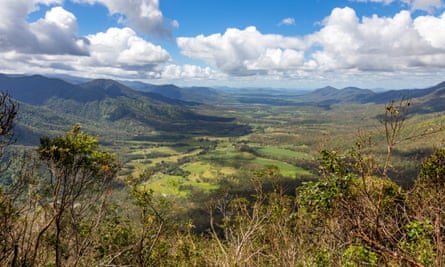Queensland’s new Liberal National party government has cancelled a Labor hydro project despite public service advice that a downsized version of the scheme would have delivered “exceptional value on both a capacity and storage basis”.
Announced under premier Annastacia Palaszczuk in 2022, the gigantic Pioneer Burdekin pumped hydro scheme formed a key element of the state’s legislated plan for a renewables transition by 2035.
The new government killed off the project last week, one of its first acts in government.
The deputy premier, Jarrod Bleijie, who had rubbished the 5,000 megawatt project as a “hoax” in opposition, on Monday released a detailed analytical report produced by Queensland Hydro under Labor.
It found the largest version of the Labor scheme was “not considered viable”, recommending the government instead build a smaller version – either the 2,500 megawatt option two or 3,750 megawatt option three.
Both were deemed viable, but option three delivered “exceptional value on both a capacity ($/MW) and storage ($/MWh) basis”, according to the report.
But the treasurer and energy minister, David Janetzki, ruled out considering a smaller version of the Pioneer Burdekin scheme, despite the recommendation.
“The people of this region have been through enough,” Janetzki said.
“We need to give clarity to the people of Eungella and their community, and that’s why the project’s not going ahead.”

Located about 70 kilometres west of Mackay, in central Queensland, the proposed project has attracted local opposition. If built, it would be the world’s largest scheme of its type, would cost $36.8bn according to Treasury estimates, and would require flooding 57 properties. It is designed to provide long duration energy storage for 2m homes and 465,000 businesses. The state is also building a second hydro project, at Borumba Dam.
Bleijie said the all three versions of the project were “essentially the same size” and would have a “exactly the same” similar impact on landowners.
“So it doesn’t matter if it’s option one, two, three, 400, it ain’t happening. We’ve cancelled it. And that was our that was our commitment to the people,” he said.
“The premier was there yesterday. And I’ve got to say the community have had a relief to know that the Liberal National government have saved their communities and their towns.”
Janetzki said options two and three hadn’t gone through a full Treasury assessment.
In opposition the LNP promised to “investigate opportunities for smaller, more manageable pumped hydro projects” as an alternative to the huge Labor scheme.
The LNP has yet to detail how many projects they want to build, where they would be built, how much power they would produce, their cost, when they would be finished or many other details of their energy policy. It plans to repeal legislation requiring a transition to renewables by 2035 and to extend the life of coal plants, but supports the state’s emissions targets.
“It is time to return an evidence based approach to our key projects, and that is what we intend to bring back to you,” Janetzki said on Monday.
The state will offer to sell back 57 properties that had been compulsorily acquired for the scheme at a cost of about $91m. Selling them back may cost an additional $15m, Janetzki said.
Emma Aisbett, the associate director of research at the ANU’s initiative on zero-carbon energy for the Asia Pacific, said it was “hard to see a good rational argument for cancelling a project” when the advice from a public agency was that it would have “strongly beneficial” outcomes.
“Given the important role for pumped hydro storage in zero-emissions electricity systems, cancelling a viable project which has already seen substantial investment in time and resources is hard to view as anything but political point scoring and a delaying tactic aimed at ensuring longer dependence on fossil fuels such as gas,” she said.
David Copeman, the Queensland Conservation Council’s director, said the government needed to make clear its energy policy as a matter of priority.
“We are concerned that other pumped hydros could actually have worse environmental impacts than Pioneer Burdekin,” he said.
“There are other potential areas in that neck in the woods that could be far worse.”
The opposition leader, Steven Miles, said Labor had always intended to “identify the most viable option” for the project and they “probably would have settled on option three” if they were still in government.
“Now that the new government has canceled that project, the pressure really is on them, now. How will they replace that storage? What will that cost? Which communities will be affected?”
The project would have cost as much as $24.7bn for option one, or as little as $17.1bn for the smallest option, according to the report. It would save as much as 9.8 megatonnes of carbon emissions for option one, 5.7 megatonnes for option two or 7.6 megatonnes for option three.
All three options deliver 120,000 MWh of energy storage capacity, but over different periods of time. Option two and three are cheaper because they require less pumping and generating units and less tunnelling, among other savings.
All three could be operating at some capacity by the end of 2035, according to the report.
Pumped hydro, like peaking gas, is a way of filling the gap in generation caused by a long-term shortage of renewables generation caused by a wind drought.
Source: theguardian.com



















